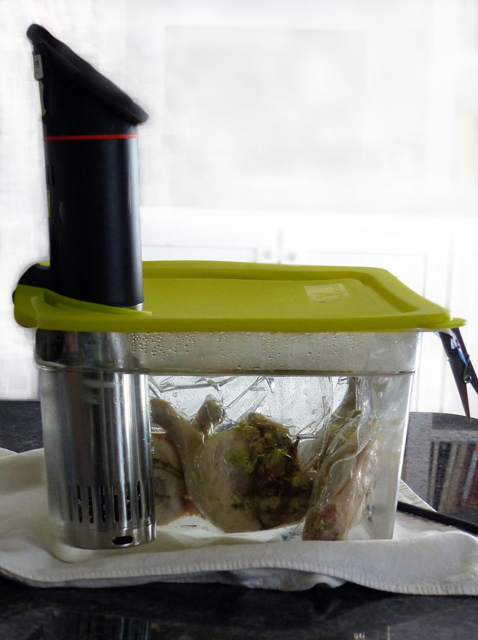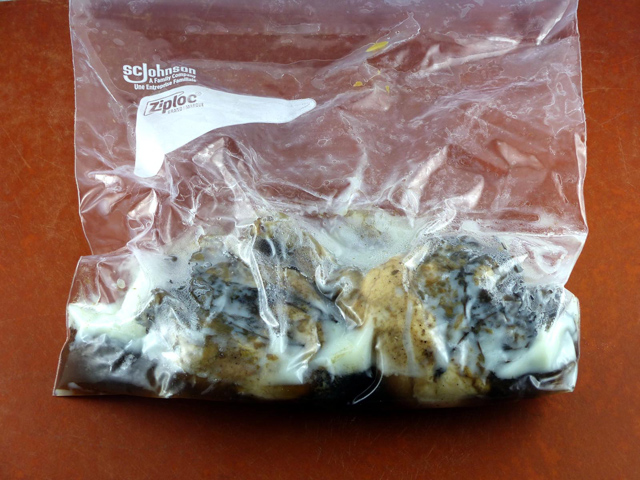On a recent visit to the magical region of Southwest France, I was delighted to find duck confit offered on numerous restaurant menus. Originating from Gascony (the modern-day French departments of Gers, Landes and Hautes Pyrénées), duck confit uses a traditional method for preserving meat and poultry. The word confit comes from the French verb confire, “to preserve.” The process involves first curing the meat with salt and sometimes other seasonings like herbs, and then gently cooking it in rendered fat. After cooling, the meat is completely submerged in fat for storage in a cool place.
Naturally when I returned to Vermont, I was eager to try my hand at making duck confit. With modern refrigeration, the goal of confit is no longer preservation but rather enjoyment of the succulent, tender duck meat. I decided to experiment with a distinctly modern method: cooking sous vide. Translated literally, sous vide means “under vacuum.” In this method, food is cooked in a sealed plastic bag in a circulating water bath at a specific temperature. This distinctly modern approach gives the benefit of precise temperature control, and it allows you to cook at lower temperatures, which can make proteins more tender.
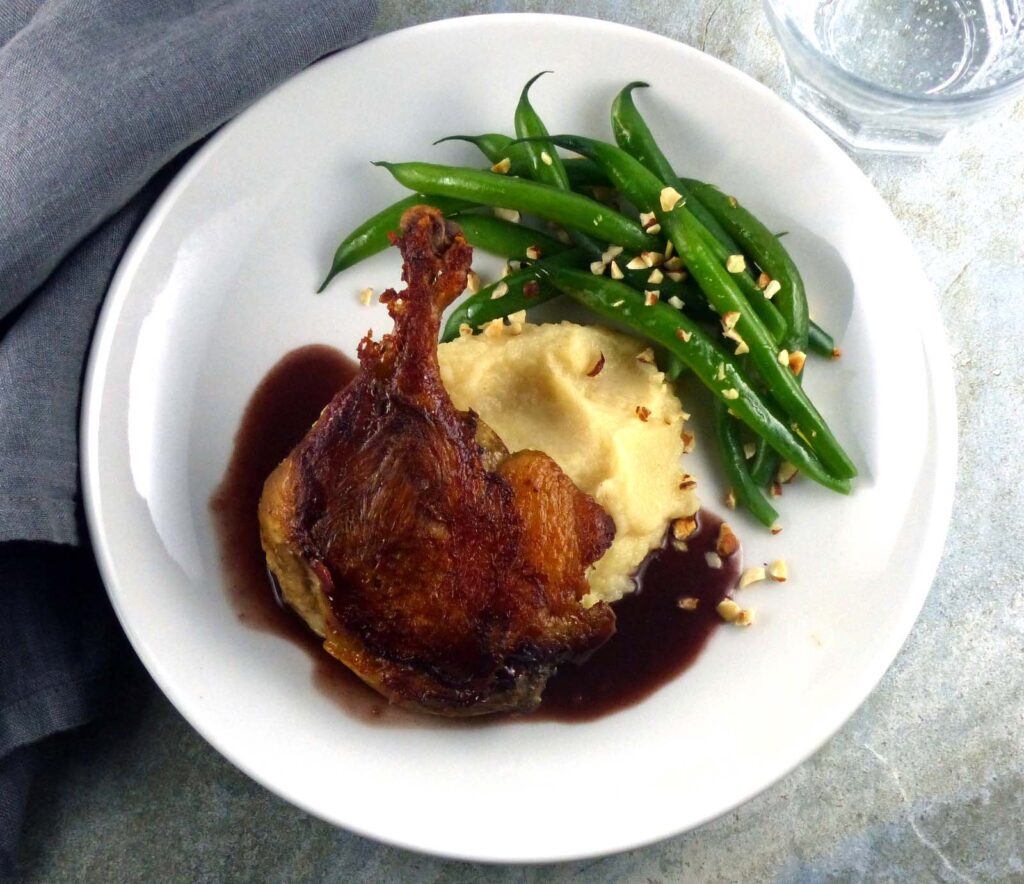
Sous vide immersion circulators are widely available these days. The Breville Joule Sous Vide and the Anova Culinary Sous Vide Precision Cooker are two popular brands. While immersion circulators are not designed for getting dinner on the table in a flash, they are superb for cooking foolproof steaks and silky textured chicken breasts. They’re also useful for tenderizing budget cuts of meat. When I tried using sous vide for duck confit, I was thrilled with the results. The duck meat was exceptionally tender and flavorful. Rich duck juices accumulated in the bag and formed the basis of a delicious sauce. I share the recipe below.
If you prefer to make a traditional duck confit, I recommend that you consult Paula Wolfert’s recipe in her book The Cooking of Southwest France (1983). Wolfert also offers a simplified duck confit recipe in Paula Wolfert’s World of Food(1998). Of course, you can find numerous recipes online.
If all this talk about duck confit makes you salivate, but you are not up for making a confit, you can buy it ready-made. I’ve purchased prepared duck confit at the IGA just across the border in Sutton, Québec. Or when you’re visiting the Eastern Townships, you could stop at the boutique at Canards Lac Brome in Knowlton. You can also order prepared duck confit from D’Artagnan.
A few tips:
- This recipe takes time, about 16 hours, but most of it is hands off. Just be sure to monitor the water level of the water bath and add additional water, if necessary, to keep the bags fully submerged.
- Where to find duck legs? I have found fresh Cryovac-packed duck legs locally at City Market and Healthy Living. You can sometimes find them at large supermarkets. While duck legs are not cheap, they are much less expensive than breasts.
- The accumulated duck juices, spiked with some Port wine, make a simple but fabulous sauce. Reduce the liquid sightly, then thicken it with a cornstarch slurry—just enough to give the sauce body. A swirl of butter at the end gives the sauce a velvety finish.
- Sous vide duck confit is actually a practical make-ahead dish. When you remove the duck legs from the circulating water bath, you chill them quickly in an ice bath. Then you can store them in the refrigerator for up to 5 days. At serving time, just crisp up the skin and finish the sauce.
How to serve duck confit? The classic accompaniment is potatoes cooked in duck fat. Duck confit is a key component in cassoulet, the hearty bean and sausage casserole from Southwest France. The shredded meat is extremely versatile. You can use it in place of beef to make a hachis parmentier, which is basically a French version of shepherd’s pie. At a recent dinner, I served crisped duck confit with Celery Root-Pear Puree and green beans. During the warmer months, I like to serve the duck with a salad of hearty greens, such as frisée and arugula, tossed in a vinaigrette.
Sous Vide Duck Confit
Equipment: Immersion circulator; 2 or 4 vacuum bags or quart- or gallon-size sealable food storage bags, such as Ziploc
Timing: 16 hours in the immersion circulator. 30 minutes chilling in an ice bath. About 20 minutes to make the sauce and brown the duck just before serving.
To make ahead: After removing the bags of duck from the water bath, chill them quickly in an ice bath, and then refrigerate the bags for up to 5 days.
Ingredients
4 duck legs (about 2¼ pounds total)
1½ teaspoons Morton kosher salt or 2 ½ teaspoons Diamond Crystal kosher salt (see Note)
Freshly ground black pepper to taste
4 cloves garlic, minced
4 sprigs fresh thyme
1/3 cup Madeira or Port wine
2 teaspoons cornstarch, mixed with 1 tablespoon water
2 teaspoons butter
Preparation
1. To cook the duck legs sous vide: Prepare a water bath, and set the temperature of an immersion circulator at 158°F (70°C).
2. While the water bath heats, pat the duck dry. Season with salt and pepper. Press the garlic onto the meaty side of each leg. Place the duck in vacuum bags or sealable food storage bags. Either place each leg in its own quart-size bag, or place two legs in a single layer in each of two gallon-size bags. Tuck the thyme sprigs into the bags, placing them on the meaty side of each duck leg. If using a vacuum bag, seal according to manufacturer’s instructions.
3. When the water bath comes to temperature, if you’re using vacuum bags, gently drop the sealed bags into the water bath. If you’re using sealable food storage bags, follow the Archimedes principle: One at a time, carefully lower the bags into the water, allowing the pressure of the water to force the air out of the bag. When the bag is almost totally submerged, seal it, and let it fall into the water. Make sure the bags are not touching. I like to clip the tops of the bags to the sides of the water bath with clothespins or binder clips.
If a bag floats, weight it down by placing a wet kitchen towel or plate on top. Cover the water bath container with a cover or plastic wrap to reduce evaporation. Cook for 16 hours. Check the water level occasionally and add more water as needed. To maintain a constant temperature, I use an instant-read thermometer to make sure that the water added is 158°F (70°C).
4. When the cooking time is complete, fill a large bowl with equal amounts of ice cubes and water. Place the bags in the ice bath for 30 minutes to chill them quickly. Then remove them, pat them dry, and transfer them to the refrigerator. (You can store the bags in the refrigerator for up to 5 days.)
5. At serving time, make the sauce and crisp the duck legs: Preheat the broiler. Line a rimmed baking sheet with foil and set a rack on top.
6. Carefully remove the duck legs from the bags and set them aside. Discard the thyme sprigs. Transfer the accumulated dark jelled juices into a small saucepan. Add the wine and bring to a simmer. Cook, uncovered, over medium-low heat until the sauce is reduced slightly, 5 to 7 minutes. Stir the cornstarch and water together, and add just enough of the mixture to give the sauce body, whisking constantly. Remove the sauce from the heat, and whisk in the butter until it melts. (Reserve the cream-colored fat in the bags for cooking—try it with roast potatoes.)
7. Meanwhile, pat the duck legs dry, and arrange them, skin side up, on the rack. Broil until the tops are crisp and deep golden brown, about 5 minutes. Carefully flip the legs, taking care not to pierce the skin. Broil until the second side is golden brown, 3 to 5 minutes.
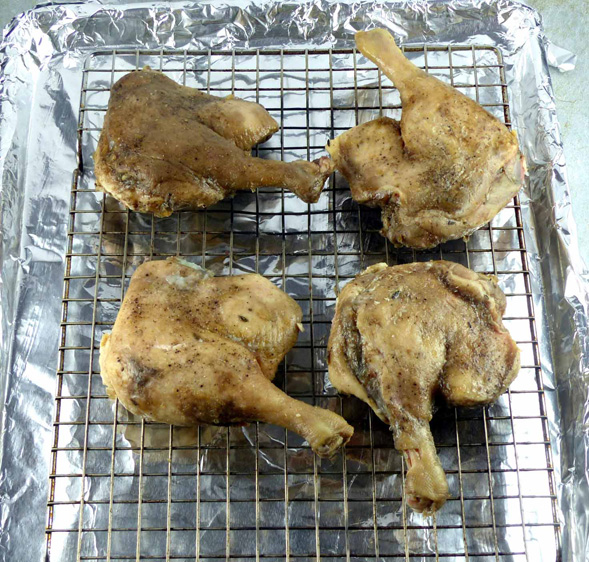
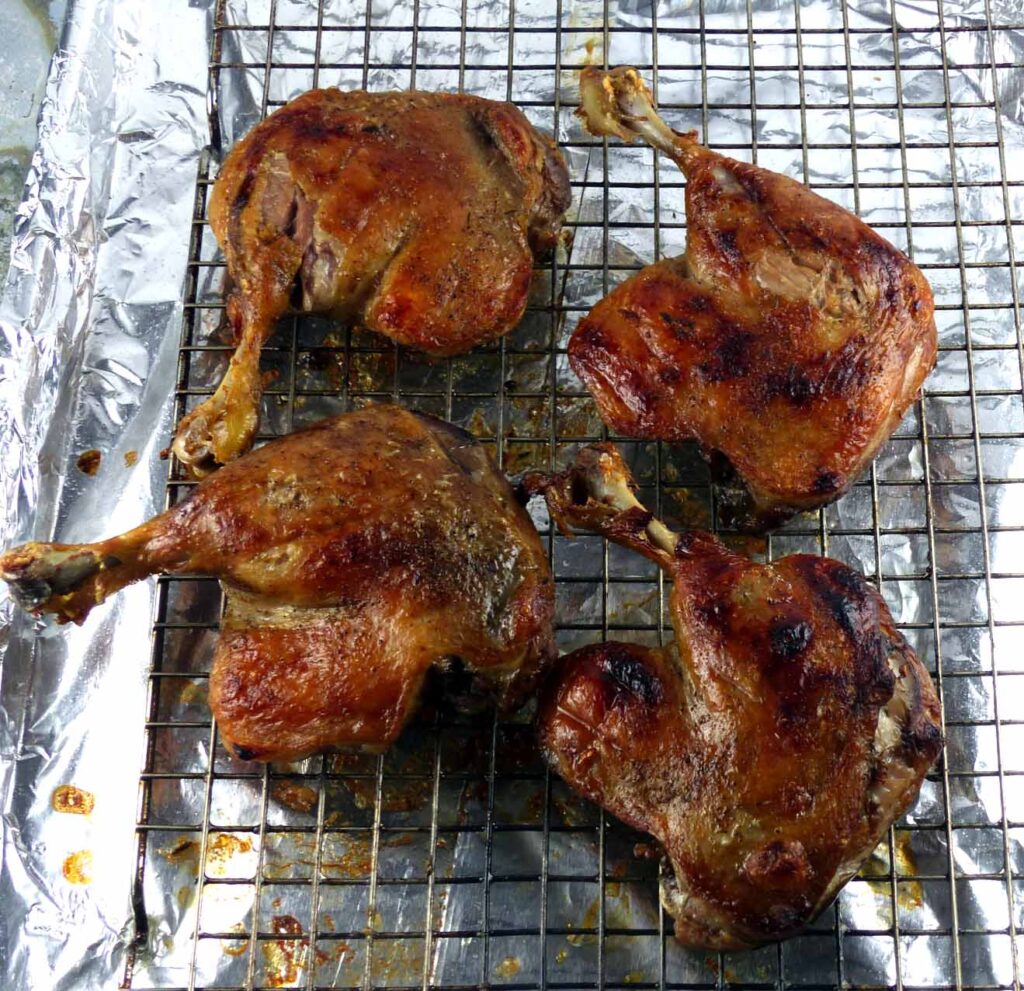
Serve the duck with the sauce.
Yield: Serves 4 (1 duck leg and about 2 tablespoons sauce each).
Note: Between the two common brands of kosher salt, the salt crystals differ in size. When measured by weight, the degree of saltiness is the same. But when measured by volume, the degree of saltiness is different. You will need more Diamond Crystal kosher salt to achieve the same salty taste as Morton, and vice versa.
Patsy Jamieson
